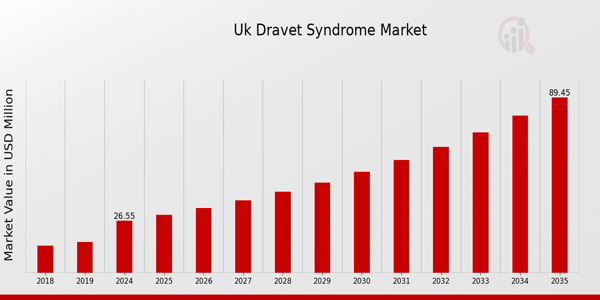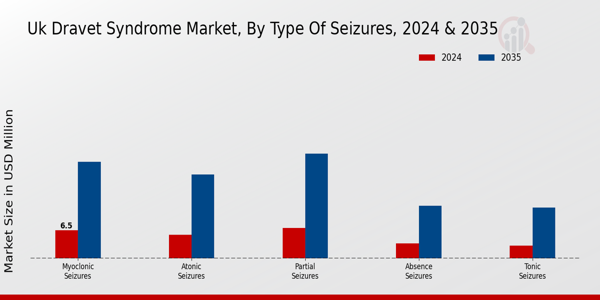UK Dravet Syndrome Market Overview
As per MRFR analysis, the UK Dravet Syndrome Market Size was estimated at 24.75 (USD Million) in 2023. The UK Dravet Syndrome Market Industry is expected to grow from 26.55(USD Million) in 2024 to 89.45 (USD Million) by 2035. The UK Dravet Syndrome Market CAGR (growth rate) is expected to be around 11.675% during the forecast period (2025 - 2035).
Key UK Dravet Syndrome Market Trends Highlighted
The UK Dravet Syndrome market is seeing remarkable developments as a result of increased awareness and advances in treatment options for this uncommon type of epilepsy. The increased frequency of Dravet Syndrome is a major market driver in the area, prompting healthcare professionals and institutions to focus on research and innovation in effective therapy.
This has inspired collaboration between pharmaceutical corporations and academic institutions to improve medication development techniques that are specially tailored to the unique needs of patients suffering from this severe ailment. Opportunities in the UK market focus on the development of targeted medicines, particularly those that make use of the most recent advances in genetic research and personalized medicine. The United Kingdom is emerging as a hub for clinical studies focusing on novel therapeutic alternatives like cannabinoid-based medicines, which have shown promise in controlling Dravet Syndrome seizures.
The rising acceptability of these alternative therapies among healthcare practitioners and patients opens up a tremendous potential to reach a larger patient population. Recent trends also point to a shift toward comprehensive care approaches that bring together neurologists, psychiatrists, and nutritional specialists to meet the holistic requirements of Dravet Syndrome patients.
The UK National Health Service (NHS) promotes a multidisciplinary approach to care, ensuring that patients receive enough assistance not only for medicine but also for lifestyle management. Furthermore, telemedicine use is growing, giving families faster access to professional consultations, which can greatly enhance patient outcomes. This emphasis on integrated care and accessibility represents a substantial shift in the way Dravet Syndrome is addressed in the UK.

Source: Primary Research, Secondary Research, MRFR Database and Analyst Review
UK Dravet Syndrome Market Drivers
Increasing Awareness and Diagnosis of Dravet Syndrome
In the UK, there has been a significant increase in awareness regarding Dravet Syndrome, which is a severe form of epilepsy that begins in childhood. This increased awareness has led to a greater number of diagnoses as healthcare professionals are more educated about the condition.
The National Health Service (NHS) reports that approximately 1 in 15,700 individuals are affected by Dravet Syndrome in the UK. Furthermore, guidelines from the National Institute for Health and Care Excellence (NICE) have emphasized the importance of early diagnosis and treatment, potentially increasing the number of patients diagnosed in the coming years.
The rigorous focus on escalating brain diseases by established healthcare organizations contributes to increased research investment and growth in the UK Dravet Syndrome Market Industry, empowering the sector to target therapeutic innovations that address this rare epilepsy.
Growth in Research and Development Activities
As the UK government continues to emphasize the importance of medical research, funding for epilepsy and rare diseases, including Dravet Syndrome, has risen dramatically. In the past few years, UK funding bodies like UK Research and Innovation (UKRI) have allocated millions of pounds to research initiatives aimed at understanding and treating Cav1.2 channelopathies, which are linked to Dravet. This funding surge has led to advancements in therapeutic options, including new medications designed specifically for Dravet Syndrome.
A report from UKRI indicated that research funding for neurological disorders has increased by nearly 30% over the last five years, enhancing the development of specialized treatments in the UK Dravet Syndrome Market Industry.
Expanding Treatment Options and Approvals
The UK Dravet Syndrome Market Industry has been positively impacted by the recent approvals of new treatments and therapies. The UK Medicines and Healthcare Products Regulatory Agency (MHRA) has granted approvals to several medications targeting Dravet Syndrome, including cannabidiol (CBD) oil.
In March 2021, the MHRA approved Epidyolex for use in treating Dravet Syndrome, expanding the treatment options available for patients significantly. This move has made it easier for patients to access new therapies and has widened the therapeutic avenues for healthcare professionals in the UK, thereby contributing to the anticipated growth of the market as more treatment options are made available.
Supportive Government Policies and Initiatives
The UK government has instituted various policies aimed at improving healthcare access for rare disease patients, including those affected by Dravet Syndrome. The recently introduced Innovative Medicines Fund has made funds available to support the development of new treatments for rare diseases. Additionally, the National Health Service is rolling out initiatives that prioritize access to healthcare resources and assistance for patients with epilepsy.
This supportive environment has led to increased investment and interest from pharmaceutical companies in the UK Dravet Syndrome Market Industry, fostering innovation and optimizing treatment pathways for affected individuals.
UK Dravet Syndrome Market Segment Insights
Dravet Syndrome Market Type of Seizures Insights
The UK Dravet Syndrome Market is characterized by a diverse range of seizure types that significantly influence treatment strategies and patient management. Among the various types of seizures associated with Dravet Syndrome, myoclonic seizures often emerge as a prominent concern due to their abrupt onset and potential to cause injuries. These seizures can challenge daily activities and are critical in shaping patient care plans. Atonic seizures, characterized by a sudden loss of muscle tone, contribute further complexity to the management of Dravet Syndrome, necessitating careful monitoring and intervention strategies tailored to individual needs.
Partial seizures, which involve localized brain activity, are also common and require specific therapeutic approaches that differ from those used for generalized seizures. Absence seizures, though less prevalent, introduce an additional layer of difficulty, as they may go unnoticed in patients, leading to underreporting and misdiagnosis. Tonic seizures, which are marked by muscle stiffness, can significantly impact a patient's mobility and safety, highlighting the importance of tailored treatment solutions. Additionally, photosensitive seizures pose unique challenges, particularly within certain environmental contexts, making awareness and preventive strategies important for individuals living with Dravet Syndrome.
Furthermore, the “Others” category encapsulates various less common seizure types that may arise, underscoring the diverse clinical presentations within this patient population. The ongoing advancements in therapeutic interventions and the increased understanding of the underlying causes of these seizures represent significant opportunities for improving patient outcomes. As the UK Dravet Syndrome Market continues to evolve, addressing the nuances and complexities of each seizure type will remain essential in ensuring effective care and improving the quality of life for affected individuals.

Source: Primary Research, Secondary Research, MRFR Database and Analyst Review
Dravet Syndrome Market Disease Diagnosis Insights
The Disease Diagnosis segment within the UK Dravet Syndrome Market has shown significant growth, deeply influenced by advancements in technology and rising awareness regarding early detection methods. Magnetic Resonance Imaging (MRI) is crucial for identifying potential abnormalities in patients, aiding in the comprehensive evaluation of brain structure.
Electroencephalography (EEG) plays an essential role in monitoring electrical activity in the brain, which is fundamental for diagnosing seizure disorders commonly associated with Dravet Syndrome.SCN1A testing has gained prominence due to its capacity to identify genetic mutations associated with the syndrome, thereby allowing for more precise patient management and treatment strategies.
Other diagnostic methods complement these techniques, ensuring a holistic approach to diagnosing Dravet Syndrome. The growing focus on personalized medicine drives the demand for these diagnostic tools as healthcare providers seek to enhance treatment outcomes. With the approval of new technologies and increased funding for rare disease research, the UK Dravet Syndrome Market continues to expand, promising enhanced diagnostic capabilities for clinicians and better support for affected families.
Dravet Syndrome Market Treatment Management Insights
The Treatment Management segment of the UK Dravet Syndrome Market focuses on various innovative approaches to help manage the symptoms of this complex and severe form of epilepsy. Seizure Medications play a pivotal role in providing symptomatic relief and improving the overall quality of life for patients, as pharmacological interventions are the first line of treatment. The Ketogenic Diet has also gained attention for its effectiveness in reducing seizure frequency, offering a dietary alternative for patients who may not respond well to medication alone.
Vagus Nerve Stimulation is another important modality that offers a surgical option for treatment, fostering a growing interest in neuromodulation techniques. Furthermore, other innovative therapies, including psychological support and lifestyle modifications, are essential components of comprehensive care for Dravet Syndrome.
The increasing prevalence of this condition in the UK, coupled with the need for effective treatments, drives significant growth in the Treatment Management segment, creating numerous opportunities for emerging therapies and clinical approaches.
The collaborative efforts among healthcare providers and researchers aim to continually enhance treatment options in this evolving segment of the UK Dravet Syndrome Market.
Dravet Syndrome Market End-User Insights
The UK Dravet Syndrome Market, particularly in the End-User segment, showcases a diverse and expanding landscape. Pharmaceutical companies play a crucial role in driving innovation and development of new treatments tailored to the needs of patients suffering from this severe form of epilepsy.
Hospitals are significant as they provide critical care and specialized services for managing Dravet Syndrome, making them vital in delivering comprehensive patient support. Diagnostic laboratories contribute essential services by offering accurate testing and screening, which are pivotal for timely diagnosis and effective treatment management.
Additionally, academic and research institutes are key players in advancing knowledge about Dravet Syndrome, often focusing on understanding its underlying mechanisms and exploring new therapeutic options. Other entities in this market segment also contribute, ensuring a well-rounded ecosystem that supports the needs of patients and healthcare systems.
The UK government has also emphasized initiatives to improve care and research for epilepsy, including Dravet Syndrome, further boosting market dynamics. As a result, the End-User segment is characterized by a dynamic interplay of innovation, research, and patient care, positioning it as an integral part of the UK Dravet Syndrome Market industry.
UK Dravet Syndrome Market Key Players and Competitive Insights
The UK Dravet Syndrome Market has experienced significant growth and development in recent years, shaped by a combination of innovative drug therapies, enhanced research initiatives, and increased awareness surrounding this rare form of epilepsy. As more stakeholders engage with this niche market, a clearer picture of the competitive landscape has emerged.
This involves not only understanding the existing players but also assessing market strategies, identifying gaps for potential entrants, and recognizing the dynamics that drive demand for effective treatments.
The complexities of the market are further heightened by the regulatory landscape, which governs the approval and management of treatments for Dravet Syndrome in the UK, and the evolving needs of patients, caregivers, and healthcare providers.
Insolia Therapeutics has established a solid presence in the UK Dravet Syndrome Market, bolstered by its strong research and development capabilities, focused commitment to addressing unmet medical needs, and established relationships with healthcare providers. The company’s strength lies in its dedicated approach to developing targeted therapies designed specifically for patients with Dravet Syndrome, emphasizing efficacy, safety, and accessibility.
By concentrating its efforts on this specific condition, Insolia Therapeutics is positioned well to meet the demands of a unique patient population. Furthermore, its investment in local partnerships and collaborations within the UK healthcare ecosystem enhances its credibility, providing the company with an in-depth understanding of market dynamics and opportunities for growth in the region.
Sage Therapeutics, while also making its mark in the UK Dravet Syndrome Market, has focused on delivering innovative treatment solutions through a pipeline of products designed for neurological conditions.
The company's key products often leverage novel mechanisms of action to provide safer and more effective treatment options. Sage Therapeutics’ strength in the market lies in its robust clinical trial programs and a commitment to addressing the specific needs of Dravet Syndrome patients in the UK. With strategic mergers and acquisitions aimed at expanding its portfolio and enhancing its research capabilities, Sage Therapeutics continues to position itself as a significant player in the UK market.
Its ongoing collaborations with local healthcare institutions further solidify its presence, allowing the company to remain agile and responsive to the nuances of the UK healthcare landscape. This proactive engagement helps to ensure that Sage Therapeutics can adapt to evolving patient needs and regulatory challenges within the UK Dravet Syndrome Market.
Key Companies in the UK Dravet Syndrome Market Include
- Insolia Therapeutics
- Sage Therapeutics
- UCB
- Eisai Co.
- Hikma Pharmaceuticals
- Biogen
- Aurora Cannabis
- Eisai
- Acacia Pharma
- Vertex Pharmaceuticals
- Zogenix
- GW Pharmaceuticals
- Jazz Pharmaceuticals
- Marinus Pharmaceuticals
UK Dravet Syndrome Market Industry Developments
The UK Dravet Syndrome Market has seen notable recent developments, particularly with new treatment approvals and ongoing clinical trials. In October 2023, Vertex Pharmaceuticals announced a significant advancement in their clinical program for a novel therapy targeting Dravet Syndrome, indicating strong potential for market growth. Concurrently, Biogen and Zogenix have intensified their research collaborations, focusing on innovative therapies, which are expected to enhance competitive dynamics in the market.
Furthermore, Hikma Pharmaceuticals has launched generic formulations aimed at addressing cost and access issues related to existing Dravet treatment options, reflecting a trend toward affordability in the healthcare landscape. In terms of market valuation, companies like GW Pharmaceuticals and Jazz Pharmaceuticals have experienced valuation increases due to positive clinical data releases, suggesting heightened investor confidence in the future of innovative therapies for Dravet Syndrome.
Notably, Acacia Pharma and Aurora Cannabis have been exploring avenues for integrating cannabinoid-based therapies in their portfolios, aligning with emerging research trends in treatment approaches. The UK regulatory environment continues to evolve, further supporting advancements in the Dravet Syndrome market, bolstered by the recent focus on rare diseases within the National Health Service (NHS).
UK Dravet Syndrome Market Segmentation Insights
Dravet Syndrome Market Type of Seizures Outlook
- Myoclonic seizures
- Atonic seizures
- Partial seizures
- Absence seizures
- Tonic seizures
- Photosensitive seizures
- Others
Dravet Syndrome Market Disease Diagnosis Outlook
- Magnetic Resonance Imaging
- Electroencephalography
- SCN1A testing
- Others
Dravet Syndrome Market Treatment Management Outlook
- Seizure Medications
- Ketogenic Diet
- Vagus Nerve Stimulation
- Others
Dravet Syndrome Market End-User Outlook
- Pharmaceutical Companies
- Hospitals
- Diagnostic Laboratories
- Academic research institutes
- Others
| Report Attribute/Metric Source: |
Details |
| MARKET SIZE 2018 |
24.75(USD Million) |
| MARKET SIZE 2024 |
26.55(USD Million) |
| MARKET SIZE 2035 |
89.45(USD Million) |
| COMPOUND ANNUAL GROWTH RATE (CAGR) |
11.675% (2025 - 2035) |
| REPORT COVERAGE |
Revenue Forecast, Competitive Landscape, Growth Factors, and Trends |
| BASE YEAR |
2024 |
| MARKET FORECAST PERIOD |
2025 - 2035 |
| HISTORICAL DATA |
2019 - 2024 |
| MARKET FORECAST UNITS |
USD Million |
| KEY COMPANIES PROFILED |
Insolia Therapeutics, Sage Therapeutics, UCB, Eisai Co., Hikma Pharmaceuticals, Biogen, Aurora Cannabis, Eisai, Acacia Pharma, Vertex Pharmaceuticals, Zogenix, GW Pharmaceuticals, Jazz Pharmaceuticals, Marinus Pharmaceuticals |
| SEGMENTS COVERED |
Type of Seizures, Disease Diagnosis, Treatment & Management, End-User |
| KEY MARKET OPPORTUNITIES |
Increased awareness and education initiatives, Development of novel therapies, Growth of telehealth services, Expansion of genetic testing, Enhanced patient support programs |
| KEY MARKET DYNAMICS |
Increasing prevalence rates, Growing patient awareness, Emerging treatment options, Rising research initiatives, Regulatory support for therapies |
| COUNTRIES COVERED |
UK |
Frequently Asked Questions (FAQ) :
The UK Dravet Syndrome Market is expected to be valued at 26.55 million USD in 2024.
By 2035, the UK Dravet Syndrome Market is projected to reach a value of 89.45 million USD.
The market is anticipated to grow at a compound annual growth rate of 11.675% from 2025 to 2035.
By 2035, Myoclonic seizures are projected to dominate the market with a value of 22.25 million USD.
The market for Atonic seizures is expected to be valued at 5.5 million USD in 2024.
Major players in the market include UCB, Biogen, and GW Pharmaceuticals among others.
The market for Partial seizures is expected to reach 24.1 million USD by 2035.
Challenges such as regulatory hurdles and competition among key players are affecting market growth.
The Absence seizures market is expected to be valued at 3.5 million USD in 2024.
Opportunities for growth are emerging from advancements in treatment options and increasing awareness.















